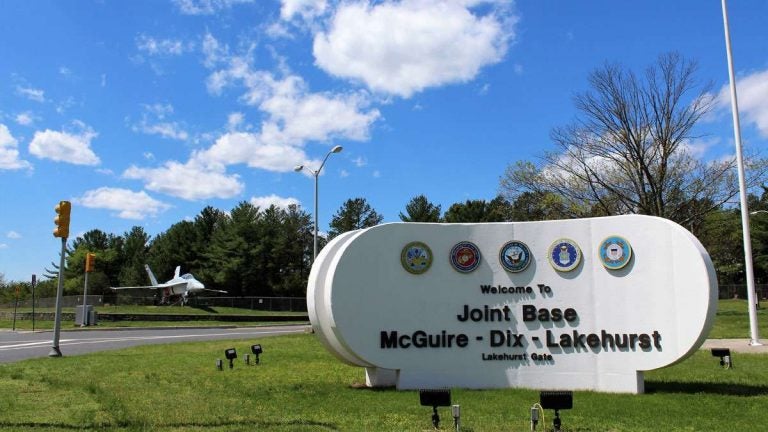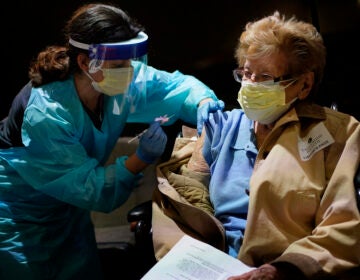Study: PFAS levels at N.J. base 24,000 times higher than proposed fed standard

Some of the highest levels of PFAS contamination have been found on military bases like Joint Base McGuire-Dix-Lakehurst, because the chemicals have been used for years in firefighting foam, and persist in groundwater. (Bill Barlow for WHYY)
Water sources at New Jersey’s Joint Base McGuire-Dix-Lakehurst contained levels of toxic PFAS chemicals that were up to 24,000 times higher than a health limit recommended by a federal agency this year, according to a new national analysis by the Union of Concerned Scientists.
The nonprofit compared the results of Defense Department testing with the limits proposed by the Agency for Toxic Substances and Disease Registry and found that the presence of some PFAS (perfluoroalkyl sulfonate) chemicals exceeded the agency’s proposed levels at the base by even more than they did when compared with looser standards advocated by the Environmental Protection Agency.
Previously reported DOD testing in 2016 found two of the chemicals, PFOA (perfluorooctanoic acid) and PFOS (perfluorooctanesulfonic acid), as high as 264,300 parts per trillion (ppt) among many sites tested in and around the sprawling South Jersey military base. That was 24,027 times higher than the 11 ppt recommended by the ATSDR as the upper limit for safe human consumption, the Union of Concerned Scientists said.
It also sharply exceeded an EPA health guideline of 70 ppt for the two chemicals combined.
Nearby population at risk?
Using DOD data, the analysis also noted that 27,879 people live within three miles of the base, potentially exposing them to hazardous levels of the chemicals that are linked to illnesses including kidney and testicular cancers, ulcerative colitis, and thyroid disease. The study covered 131 bases nationwide, and found the highest PFAS concentrations, at up to 1 million times the ATSDR level, at bases in Louisiana, California, Florida, and Delaware.
In New Jersey, the DOD found three private wells near the McGuire base contained the two chemicals at a level that exceeded the EPA’s recommendation. It provided homeowners there with bottled water until filtration systems were installed.
The report also compared PFOS and PFOA contamination at the former Naval Air Warfare Center in Trenton, and found it was 2,527 times above the ATSDR’s safe health level.
Nationwide, some of the highest levels of PFAS contamination have been found on military bases like Joint Base McGuire-Dix-Lakehurst, because the chemicals have been used for years in firefighting foam, and persist in groundwater. In other locations, the contamination has been traced to the manufacture of consumer products such as nonstick cookware and flame-retardant fabrics.
EPA levels for PFAS too low
Advocates for stricter health limits on the chemicals say the EPA’s levels are too high to protect public health.
In the absence of federal leadership on the issue, some states, including New Jersey, have started to regulate the chemicals at much lower limits than the EPA’s. New Jersey’s Department of Environmental Protection is implementing its first PFAS regulation — on the chemical PFNA — and considering recommendations for tough new limits on two other PFAS chemicals.
When the PFNA (perfluorononanoic acid) regulation becomes effective, military bases will have to comply with the state’s new limit, said Larry Hajna, a spokesman for the DEP.
‘Public relations nightmare’
Earlier this year, campaigners welcomed the release of ATSDR standards for 14 of the most common types of PFAS. For two of them, PFOA and PFOS, the agency recommended health limits that are seven to 10 times stricter than EPA’s. The 852-page ATSDR report followed the publication of emails from unnamed EPA and White House officials who argued against the release, saying they feared a “public relations nightmare” if they had to explain the wide difference between the recommendations of two federal agencies.
The UCS report highlights the sharp differences between the ATSDR’s recommended levels, the EPA recommendations, and the actual degree of contamination on military bases, as shown by existing DOD data.
“The thing that’s new is the ATSDR-suggested level, which is well below the EPA’s standard, and now means that we should view this contamination as even more problematic because ATSDR says that quite low levels of PFAS are harmful,” said Dr. Andrew Rosenberg, a UCS scientist.
A spokesman for the joint base was asked whether the military has reduced the contamination since the 2016 testing but did not respond to that question. The U.S. Air Force said on its website that it will supply bottled drinking water to anyone whose private well exceeds the EPA limit for PFOA and PFOS, and is testing all of its own water systems. Still, the USAF said it won’t pay for blood tests for people who live in areas where the chemicals have migrated off base.
The UCS and other advocates are now calling on the EPA to set national health limits for the chemicals, which would require water-system operators, including the military, as well as public and private utilities, to comply with a single standard.
Former EPA Administrator Scott Pruitt said in May that the agency is considering whether PFOA and PFOS should be regulated, and promised to deliver a national management plan on the issue by the end of the year.
The EPA showed its awareness of growing public concern on PFAS chemicals this summer when it conducted a national listening tour of affected sites including the eastern Pennsylvania towns of Horsham, Warrington, and Warminster, whose water systems have been affected by PFAS runoff from nearby military bases. But even if the EPA decides to regulate the chemicals, critics say it will likely be years before federal rules are implemented.
In Pennsylvania, Gov. Tom Wolf in September set up an “action team” of state officials to advise his administration on how to curb the chemicals, which are already being cleaned up at 11 locations in the state.
NJ Spotlight, an independent online news service on issues critical to New Jersey, makes its in-depth reporting available to WHYY.
WHYY is your source for fact-based, in-depth journalism and information. As a nonprofit organization, we rely on financial support from readers like you. Please give today.




